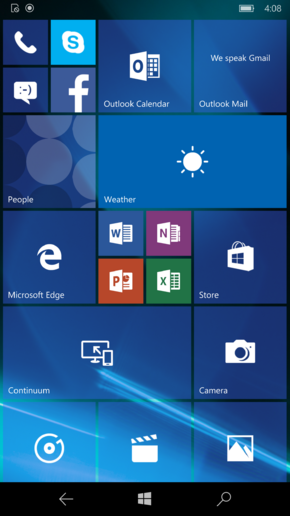Windows Phone
 | |
| Developer | Microsoft Corporation |
|---|---|
| Source model | Closed source |
| Initial release | Windows Pocket PC 2000 (19 April 2000) |
| Latest release | Windows 10 Mobile Fall Creators Update (17 October 2017) |
| Supported platforms | x86, AMD64, ARM32, ARM64 |
| Kernel type | Hybrid (CE up to WP7, NT from WP8 on) |
| License | Proprietary |
Windows Phone (previously called Windows Mobile and before that Windows Pocket PC) is a mobile operating system developed by Microsoft. The operating system was originally based on the Windows CE kernel, but with Windows Phone 8, the system transitioned to the NT kernel. Many releases of this Windows version were produced during its lifespan, with the operating system ranging focuses from first Pocket PCs, to then later smartphones.
History[edit | edit source]
The operating system’s first name, Windows Pocket PC, would be rebranded to Windows Mobile along with the change of focus to smartphones rather than Pocket PCs, with the first OS to adapt the naming scheme being Windows Mobile 2003. During the development of Windows Mobile 7, Microsoft anticipated criticism upon release due to outdated concepts as a result of the release of the Apple iPhone, and began work on a brand new version of the now called “Windows Phone” operating system that would introduce the Metro user interface, leading to the release of Windows Phone 7. The operating system would then later transition to the NT kernel in Windows Phone 8.
The final release of Windows Phone would end up being Windows 10 Mobile, which was an anticipated successor to the then mostly succesful Windows Phone 8. The original release of the operating system would have included features like Project Astoria, an Android 4.4 compatibility layer for Windows Phone, although due to logistics and stability problems, the release ended up getting postponed, and the November Update of said OS was released instead, but without many of the anticipated features, leading to criticism due to missing features and overall lagginess of the OS when compared to Windows Phone 8. The latter would however be gradually improved on with each feature update of Windows 10 Mobile.
On 8 October 2017, Microsoft announced that the company would no longer develop new features or hardware for the operating system due to low market share and the lack of third-party apps on the platform. Microsoft decided to instead focus on developing software efforts that have included providing apps and services to competing mobile operating systems like Android and iOS.[1]
As a result, the final release of the operating system, Windows 10 Mobile Fall Creators Update, would be released on 24 October 2017. The release was meant to serve as a stop gap release based on the previous feature update’s codebase as a version based on the Redstone 3 codebase was in development. Unfortunately, due to shifted focus towards the Windows Core OS project and other then ongoing problems, MobileCore, the name of the kernel for the operating system, would be discontinued on 14 January 2020, coinciding with the end of support date for Windows 7.
Timeline[edit | edit source]
Windows Pocket PC | ||||
|---|---|---|---|---|
| Name | Base OS | Release date | Support end date | |
| Windows Pocket PC 2000 | Windows CE 3.0 | 2000-04-19 | 2007-09-10 | |
| Windows Pocket PC 2002 | 2001-10-04 | 2008-10-14 | ||
Windows Mobile | ||||
| Name | Base OS | Release date | Support end date | |
| Windows Mobile 2003 | Windows CE 4.2 | 2003-06-23 | 2014-07-08 | |
| Windows Mobile 5.0 | Windows CE 5.1 | 2005-05-09 | 2015-10-13 | |
| Windows Mobile 6.0 | Windows CE 5.2 | 2007-02-12 | 2013-01-08 | |
| Windows Mobile 6.1 | 2008-04-01 | |||
| Windows Mobile 6.5 | 2009-05-11 | |||
Windows Phone | ||||
| Name | Base OS | Release date | Support end date | |
| Windows Phone 7 | Windows CE 6.0 | 2010-10-21 | 2014-10-14 | |
| Windows Phone 8 | Windows 8 | 2012-10-29 | 2014-07-08 | |
| Windows Phone 8.1 | Windows 8.1 | 2014-07-15 | 2017-07-11 | |
Windows 10 Mobile | ||||
| Name | Base OS | Release date | Support end date | |
| Windows 10 Mobile | Windows 10 | 2015-11-16 | 2020-01-14 | |
References[edit | edit source]
- ↑ Fingas, Jon. Microsoft exec says Windows 10 Mobile is no longer a 'focus', Engadget. 8 October 2017.
